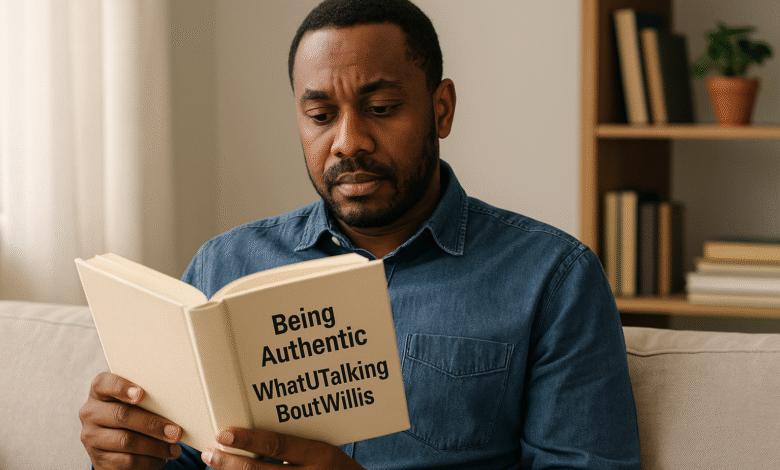Being Authentic WhatUTalkingBoutWillis: A Deeper Dive into Living Your Truth

In today’s hyper-curated world, the phrase being authentic WhatUTalkingBoutWillis isn’t just a nostalgic nod to the 1980s sitcom Diff’rent Strokes—it’s a powerful call to strip away the masks and embrace unfiltered truth. The iconic quote, once spoken with comedic flair, now resonates as a challenge against today’s widespread performative culture. This article explores the many dimensions of being authentic WhatUTalkingBoutWillis, analyzing it through psychological, neurological, and sociocultural lenses, while also offering tangible strategies for living more authentically in modern life.
The Struggle for Authenticity in a Performative Era
Living in the digital age has created a double-edged sword: on one side, we have tools for boundless self-expression; on the other, we’re bombarded with expectations to present only our most polished selves. Social media, workplace norms, and even family pressures often demand that we tailor our identity to fit in, leading to what experts describe as an “authenticity crisis.”
Recent studies show that nearly 60% of adults regularly conceal parts of themselves in social interactions, while Gen Z spends around 68% of their day in some form of performative mode. This gap between who we are and who we present to the world is precisely what being authentic WhatUTalkingBoutWillis seeks to challenge.
The Brain Behind the Mask: Neuroscience of Authenticity
The phrase being authentic WhatUTalkingBoutWillis isn’t just psychological—it’s neurological. Neuroscience offers compelling data on how our brains function when we’re genuine compared to when we’re pretending.
Authentic self-expression activates a network in the brain that includes the ventromedial prefrontal cortex (self-reflection), anterior cingulate cortex (emotional balance), and the insula (bodily awareness). This network produces a “neural signature of congruence,” which aligns our internal thoughts with our external behavior. It also leads to dopamine and oxytocin release—hormones associated with joy and connection.
In contrast, performative behavior triggers the dorsolateral prefrontal cortex (mental control) and the amygdala (anxiety), suppressing the default mode network that aids self-reflection. Over time, this misalignment causes stress, elevated cortisol levels, poor sleep, and emotional fatigue.
One study by Dr. Sarah Banks at UCLA discovered that individuals who reported high daily authenticity experienced:
-
23% lower cortisol levels
-
18% better sleep quality
-
31% higher life satisfaction
-
Greater nervous system resilience
These findings highlight that being authentic WhatUTalkingBoutWillis is not just morally satisfying—it’s biologically necessary.
Psychological Costs of a Masked Life
Long-term inauthenticity takes a toll on mental health. This includes:
1. Identity Confusion
When you constantly adjust to fit different situations, you risk losing sight of who you really are. Many find themselves struggling to answer simple questions: “What do I enjoy?” or “What do I believe?”
2. Emotional Burnout
Presenting a filtered self requires constant monitoring. Psychologists estimate we make up to 20 conscious adjustments a day just to maintain social facades.
3. Surface-Level Relationships
Connections built on pretenses often lack depth. People may like the version you present, but that doesn’t mean they know the real you.
4. Worsening Imposter Syndrome
Success achieved while being inauthentic breeds anxiety. You’re not just afraid of failure—you’re afraid of being “found out.”
These emotional burdens underline the importance of being authentic WhatUTalkingBoutWillis as a mindset of self-liberation.
Digital World, Fragmented Self
Social media intensifies the problem. While it’s marketed as a place for self-expression, it often rewards sameness and superficiality. In the realm of being authentic WhatUTalkingBoutWillis, three major online traps are identified:
-
The Highlight Reel
Most users only post idealized snapshots of life, contributing to a skewed perception of success. -
Algorithmic Homogenization
Platforms push users to conform to trending content, suppressing unique voices and encouraging filtered personas. -
The Vulnerability Economy
Authenticity itself is being commodified. Real struggles are turned into content, and sincerity becomes performance.
The result? Higher stress, fragmented self-concepts, and increased disconnection from reality—all contradicting the values of being authentic WhatUTalkingBoutWillis.
How to Practice Radical Authenticity
Moving from theory to practice, here’s how to live by the being authentic WhatUTalkingBoutWillis philosophy every day:
1. Clarify Core Values
List 3–5 non-negotiables that define who you are. Align daily decisions with these values.
2. Digital Detox
Designate “no-post” days or delay sharing content. Follow accounts that promote realness over perfection.
3. Create Boundaries
Protect your emotional space. Practice saying “no” without guilt and surround yourself with safe, authentic individuals.
4. Mindfulness Practices
Daily check-ins and journaling help bridge the gap between your inner world and outer actions.
5. Bring Your Real Self to Work
Apply the “10% more you” rule—slowly integrate more of your true self in professional settings. Find colleagues who support authenticity.
Research shows that applying these methods consistently for eight weeks can significantly boost self-esteem, reduce stress, and improve personal and professional relationships.
The Professional Authenticity Paradox
Corporate environments often send mixed signals about authenticity. Many organizations claim to value “realness,” yet subtly reward conformity. This is the authenticity double-bind—especially challenging for marginalized groups.
-
Leaders: Studies show people want authentic leaders, but leaders showing vulnerability are sometimes perceived as weak. The solution is “calibrated authenticity”—sharing real aspects of yourself without oversharing.
-
Diversity & Inclusion: Code-switching remains a survival mechanism in workplaces that don’t accommodate diverse authenticity. True inclusion must prioritize real, nuanced expression.
-
Innovation & Productivity: Teams that foster authenticity have 56% more innovation and 42% less turnover.
Forward-thinking companies are implementing tools like authenticity-based leadership training, reverse mentoring, and dedicated “authenticity hours” to shift corporate culture.
Conclusion: Realness as a Superpower
The journey toward being authentic WhatUTalkingBoutWillis isn’t easy, but it is transformative. In a society built on appearances and expectations, every act of authenticity becomes an act of rebellion—and healing.
Being authentic doesn’t mean being unfiltered in all settings. It means being consistently aligned with your values, regardless of the context. Whether in digital spaces, at work, or within intimate relationships, being authentic WhatUTalkingBoutWillis is about narrowing the gap between who you are and how you show up.
Your real self is not just enough—it’s necessary. In a world craving connection, your authenticity is a radical gift.
FAQs about Being Authentic WhatUTalkingBoutWillis
Q1: What does “being authentic WhatUTalkingBoutWillis” really mean?
It means living in alignment with your true thoughts, feelings, and values while resisting societal pressure to conform or perform.
Q2: Is it possible to be fully authentic at work?
Yes, but it requires balance. Bringing 10% more of your real self weekly can lead to stronger relationships and greater job satisfaction.
Q3: How can I tell if I’m being inauthentic?
Look for emotional exhaustion, disconnect from your core values, and superficial relationships—they’re common signs of inauthenticity.
Q4: Can social media be used authentically?
Yes, but it takes intention. Limit filters, post real moments, and curate your feed to reflect truth over trends.
Q5: Why is authenticity important?
Authenticity improves mental health, reduces stress, strengthens relationships, and fosters a deeper connection to life.



